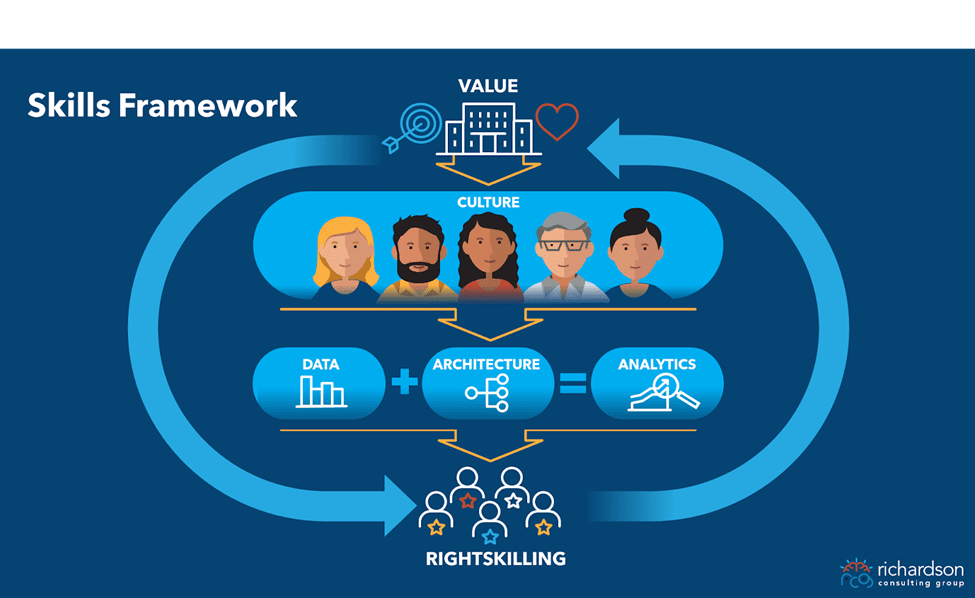
Many top HR managers, talent acquisition experts, and learning executives in medium- and large-scale companies have several questions relating to skills strategy, culture, and architecture.
How do we commit our employees to a learning culture?
How do we prepare for the next technological wave?
How do we move from a job-based organization to a skills-based one?
How do we integrate the numerous tech tools and taxonomies into our skills and learning culture?
Do we focus on current business challenges or employee self-directed learning?
Where do we start?
IThese questions and more come from business leaders and talent executives from top companies working on skills who attend our skills roundtable sessions. In these sessions, subject matter experts and industry leaders share ideas on common themes of skill strategy, skill architecture, skill culture, skill data, equity, and ethics.
In one of our recent roundtable sessions, we took a deep dive into skills strategy with a focus on building a learning culture and setting priorities for skills and expectations through an accountability framework.
Let’s begin with our skills framework to help you keep up with the rest of the discussion.

- Skills Strategic Framework
As an HR professional or talent executive, here are some basics you need to understand about building a skills strategy and culture. We review this framework in all our sessions to provide an overview for participants and lay the groundwork for subsequent discussions.
From the illustration above, you’ll see that Skills is a broad, rich and deep topic with interdependent components. These include value, rightskilling, skills culture, architecture, data, and analytics.
Rightskilling encompasses all the different strategies organizations use to get the right skills to the right place at the right time. These include hiring (buy), upskilling and reskilling existing employees (build), obtaining contingent labor (borrow), and identifying opportunities for automation (bot).
Organizations have been successful with a value-based approach where skills are used to create tangible value. This values may be driven by business metrics and/or a people (talent) focus. Business drivers may include business performance, business agility, or customer satisfaction. People strategy drivers may include productivity, career development, or employee engagement.
To do this, we need:
- A Skills Culture that enables a skills-first mindset and skills-focused behaviors.
- Skills Data that is accurate and reliable at the individual and organizational levels
- A Skills Architecture that is clear, consistent and adaptable to the changing needs of the organization.
- Skills Analytics that provide accurate, actionable data on skill supply, demand, and forecast.
Leading With Skills or Learning After Building a Culture
This came from Melanie, VP at United-Health Group Talent Office. Her company has around 375,000 employees around the world, and another 112,000 that are not integrated yet. They are currently looking at creating a culture and mindset shift before a full-blown digital transformation.
So, she wants some ideas on how to move to a skills-based organization and how to make the new culture acceptable to all.
Find out what her peers had to say
One of the keys to having a seamless skills transition is by creating a learning culture based on organizational needs. This is the approach at General Mills.
According to Dan, a senior manager at General Mills and member of the continuous improvement team, one of their main values is for every employee to have a learning (growth) mindset and this helps to start moving the culture in that direction.
For Fred, director of field learning for Envision Group, a sector within Compass Group, the answer lies in creating a locally-driven learning and skills culture.
As a company that operates on the local level with 29 different sector names, it has had success operating a general Learning Management System (LMS) for all employees while the culture remains driven by individual business units.
“It is hard to enforce a large initiative across a company if it’s coming from one space. It has to come from many spaces. And so, it might be better to take it into a chunk situation, or a smaller unit-based focus”
Melanie agreed. The way people embrace learning and skills can differ at the organization, function, and team level.
Who Better Directs a Learning Culture: Individual Employees or Management?
Another common question from roundtable participants centers around the notion by many companies that they value learning and place great emphasis on employee skills development. But is this just an inferred expectation or do employees and people leaders really make time to learn?
Greg, the director of learning at Edward Jones presents it in simple terms. His company recently made its learning platform generally available, and the aim is to create self-directed learning by helping people recognize the need to build a skill and the will to invest time in it.
To do this, they look out for the irresistible moment when skills become tangible in people’s life and career.
“The irresistible moment. That time where our population recognized that they needed to build skills and are willing to invest their time in order to do it. That’s self-directed learning rather than the programmatic learning that many learning organizations are trying to mature out of.”
The company is also experimenting with enterprise learning by introducing badged skill journeys where learning achievement is attached as a skill that signifies readiness for more advanced assignments. So, the goal of their Learning Experience Platform (LXP) is to create differentiated learning experiences that open up career doors
This approach to employee learning and building a skills culture is similar to what is obtainable at General Mills.
Dan described the company’s learning management system as pretty extensive, with access for all employees to all types of training that’s also connected to LinkedIn Learning.
Each year all employees are expected to go through a process called Individual Development Planning. So, it is up to the individual to own the learning process by determining their learning, growth and development path by discussing with their manager.
Getting Started
IOrganizations that have achieved success in creating a Skills and learning culture or are currently working on it often start with the 3 “S’’ model.

Small

Simple

Somewhere with an important, preferably urgent skill need.
Starting small and with a real business problem where the skills-based approach is going to help, can make a great difference.
One popular notion is the belief that the half-life of skills is shrinking. This may be a reason why your company is holding back from implementing a full skills-based transition. While it may be true for tech-based skills due to their transient nature, other skills such as leadership, communication, and collaboration are more permanent, evergreen skills. So, there is no better time to start than now.
If you’d like to get more ideas from industry experts and leaders, then feel free to book a space at an upcoming roundtable session. You can also book a 1:1 skills strategy session to build a snapshot of where you are and where you are headed with skills.
